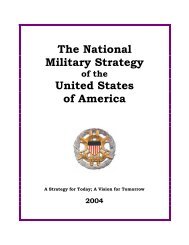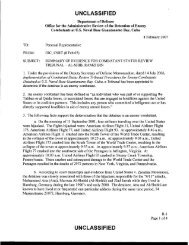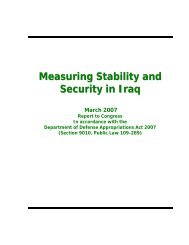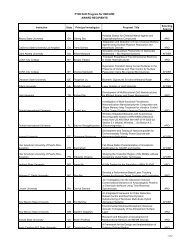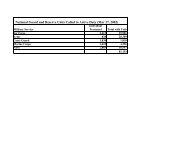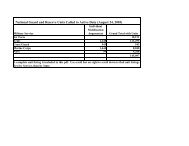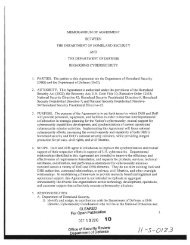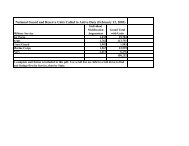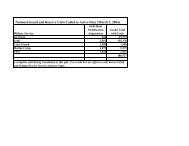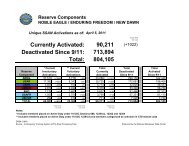Report - United States Department of Defense
Report - United States Department of Defense
Report - United States Department of Defense
You also want an ePaper? Increase the reach of your titles
YUMPU automatically turns print PDFs into web optimized ePapers that Google loves.
UNCLASSIFIED<br />
Several classes <strong>of</strong> supply, including Class I Subsistence and Class II Individual Equipment, have<br />
already been fully transitioned to ANA control and demonstrate natural velocity through the<br />
logistics system. Upcoming transition <strong>of</strong> responsibility for Class III Bulk Diesel to MoD and<br />
MoI control will require ongoing accurate documented forecasting.<br />
Retrograde policy exists for both the ANA and ANP; however, the process <strong>of</strong> replacing unrepairable<br />
weapons and vehicles has been undeveloped. The Estimated Cost <strong>of</strong> Damage (ECOD)<br />
procedure has been developed in consultation with the Afghan forces and is currently being<br />
implemented. This process, once approved and applied, will enable weapons and vehicles<br />
assessed as beyond repair to be retrograded to the national level and replaced with new items.<br />
Another problem encountered during this reporting period was ammunition management. NTM-<br />
A is making progress with transition efforts to the ANA, and training for the ANP is underway.<br />
Transition <strong>of</strong> Logistics<br />
The MoD has increased capacity for the transition <strong>of</strong> supplies. However, with an increase in<br />
complexity <strong>of</strong> supply classes, challenges have arisen regarding differences in contracting end<br />
items. The MoD will need advisory assistance in the areas <strong>of</strong> requirements generation,<br />
contracting structure, technical assessment, and contract administration for additional transition<br />
<strong>of</strong> supply classes. Supply management is still immature and needs significant support in the<br />
areas <strong>of</strong> supply planning/forecasting, effective logistics procedures, and development <strong>of</strong> organic<br />
maintenance capability.<br />
As coalition forces retrograde, the ANSF will be required to be increasingly reliant on organic<br />
Afghan logistics systems. Therefore, it is important that the ANA is fully capable <strong>of</strong> using a<br />
command-driven logistical system, which in turn is capable <strong>of</strong> independently sustaining ongoing<br />
operations and ANA forces within Afghanistan. ANA logistics policy and procedures must be<br />
robust, responsive, and coordinated to work in parallel to coalition force policies and procedures<br />
until required to stand alone after the coalition withdrawal.<br />
Oversight <strong>of</strong> the logistics system is a command responsibility and the ANA has embraced this<br />
concept through the Logistics Maintenance Terrain Walk program, which began in October<br />
2012. Afghan senior leadership, including ANA Chief <strong>of</strong> General Staff GEN Karimi, GSG4 MG<br />
Shah Aqa, and Logistics Command commanders, travel to each corps alongside COMIJC and<br />
senior levels <strong>of</strong> ISAF leadership. Corps commanders and G4 staff provide briefings and a<br />
practical walkthrough <strong>of</strong> corps, brigade, and CSSK 19 lines, which demonstrates their<br />
understanding, utilization, and increasing pr<strong>of</strong>iciency in the supply and sustainment process.<br />
Velocity and feedback during the supply and sustainment process continues to be a challenge but<br />
revision to logistics policies (commonly known as “decrees”) is ongoing at the MoD level in<br />
order to streamline the overly staff-driven sustainment procedure. Sign<strong>of</strong>f <strong>of</strong> these revisions is<br />
expected soon. Some coalition advisors report that logistics requests reaching regional or<br />
national support commands are treated with a “fill or kill” mentality, with little to no feedback<br />
19 A support Kandak focused on logistics and sustainment.<br />
74



